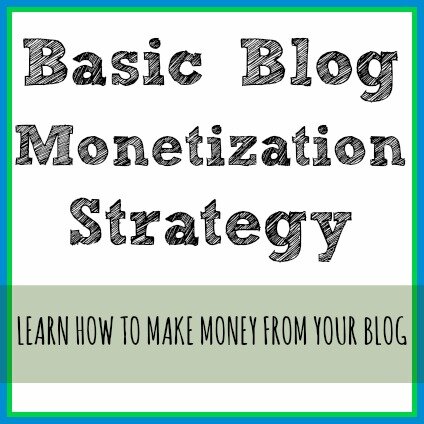

Today I am going to share with you a basic blog monetization strategy. I am going to have to keep it pretty general because all blogs are different, however after reading this post, you should be well on your way to implementing a blog monetization strategy.
There are a few things that you want to cover with a blog monetization strategy. You’re going to want to analyze some potential ways to make money on your blog, how you plan on implementing those ideas and what goals you have for earnings. You’ll also want to think about any potential road blocks along the way.
This graphic below represents the basics of any good strategy. I will explain in more detail in the post below.


When pondering ideas for monetizing your blog, it is important to keep your audience (or target audience) in mind. In a perfect world, your monetization strategy will also be adding value to your readers. You’re going to have to do some research, or do some predicting as to what will work for your audience and what they might like.
How do you do this?
If you have a blog about running, how can you add some value to your blog while also monetizing? Well, if you write about your Garmin 10 watch, add a link to the item on Amazon. Your readers now have a direct link to read more about the product, read reviews and potentially buy it. You have just added value to your post. Do the same with shoes, fitness DVDs and more.
Another thing you can do is take a look at some of the most successful running blogs and observe how they are making money. Do they have AdSense ads? Do they have privately sold ads? Are they promoting things through Amazon or another affiliate program? These are all things that you will want to consider as part of your monetization strategy. It’s a good idea to look at a few of your “industry leaders” and see what they are doing to monetize. Chances are, if you see a few blogs doing the same thing, it is working.
Again, in a perfect world, all monetization would add value to your blog. Sometimes (as with AdSense), it’s a little bit more cut-and-dry when it comes to the advertisement. Just try not to come off as having excessive ads or affiliate links. Nobody comes to your blog to be sold something.
We’re going to stick with this running blog example. If I were starting a blog about running, I would take a look at some of the bigger running blogs to see how they are monetizing. A quick look at some of the bigger running blogs show me AdSense and similar ads, an Amazon ad and a plethora of privately sold ads. (You can tell those because typically when you hold your mouse over them, the destination URL will simply be the company’s site aka Adidas.com as opposed to redirectingat.com/merchantid=adidas/affiliateid=363764 or something like that.)
That gives me a good idea of how to approach my monetization strategy. I would try to secure some private sponsorships and ad sales in addition to putting up some AdSense ads and trying to promote items through Amazon.
You definitely don’t want to rely solely on your industry leaders though, as a lot of times they are missing out on huge revenue opportunities. What you want to do is get a few ideas from them and build on them with some ideas of your own. So maybe in addition to the things the others are doing, you could join the Adidas or Reebok affiliate programs. You would expect an ad for Adidas shoes to do pretty well on a running blog, so why not try it out?
Here’s a quick look at 6 popular revenue options for blogs:
 For more specifics on all of these, I recommend you join my email list using the box below this post. That will give you free access to my ebook where I explain these in greater detail.
For more specifics on all of these, I recommend you join my email list using the box below this post. That will give you free access to my ebook where I explain these in greater detail.
Once you have a few ideas for monetization, it’s time to implement them. Here, you’re going to have to ask yourself some more questions about what to do next.
• How many private ads are you going to try to get?
• How many AdSense ads should you put up?
• Where should they go?
• How much money do you want to make?
These are all things that you have to ask yourself. As a matter of fact, I ask myself those questions on a monthly basis to make sure I am staying on top of things.
Once you implement a strategy, you’re going to want to monitor it and react accordingly. If your strategy is working, keep it up. If your AdSense ad is rocking, put another one up. If people buy from Amazon every time you add a link to your post, add more links! Go with the flow. On the flip-side, if something is not working, adjust it or try something new.
When it comes to your monetization strategy, you should always be analyzing and adjusting based on what is working and what isn’t.
As you see in the graphic above, a monetization plan is a never-ending cycle.
You’re also going to want to think a little down the road. Do you see any roadblocks for your current plan? Will the same opportunities for monetization be there in one year? Two years? Five years? Will any opportunities be there? Is there potential for much more opportunity? Is there room to grow? It is important to think carefully about things like this before jumping in.
Those are the basics of forming a blog monetization strategy. Hopefully you are able to find some areas on your blog for potential monetization and run with them.
Note: these are just basic tips for formulating a monetization strategy. I am more than happy to work with you on a 1-on-1 basis to work on your personalized monetization strategy. Please see my consultation rates for more info.






Leave a Reply